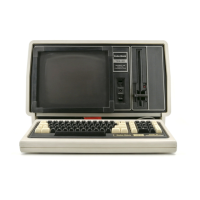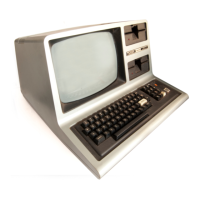Notice NOR
gate
Z30,
pins 8 and 9. These
pins
enable
Z30's output
to produce a signal called BLANK*. BLANK*
is used by the
video processor to give the 72 scan line
blanking for
the upper and lower boundaries. It
also defines
the blank boundaries
on the left and right of
the
screen.
VIDEO RAMS
The video RAMs
are
static
and hence do not need
refresh-
ing.
The
data bus is wired in the same way
as system
RAMs,
but with
a different enable signal. One interesting
point to
note: There
are seven RAMs. Six are used
for ASCII
storage, and the seventh is used
as a
graphic/alphanumeric
definition
bit. There are eight
data
lines.
Notice the line
labeled
Bit 6.
It
is sourced by NOR
gate
Z30
at pin 13. If
Bit 5 (Z62, pin
12) and
Bit 7 (Z63,
pin
12)
are low, then
Bit
6
will
be high.
Z30
is
a
sneaky
way of squeezing a
seventh ASCII bit out of six RAMs.
Aside from
the data bus, there is another RAM
output for
data. The video processor
needs video data for generation
of the alphanumeric
and graphic symbols. And this section
will be discussed
next.
VIDEO
PROCESSING
Video Processing consists of five
subsections. They
are:
data latch, character/graphic
generator, shift register,
sync
generator,
and video mixing/output driver. The
data latch
temporarily
stores an ASCII or graphic
word from video
RAM.
The latch will retain the byte
for processing
so that
the RAM is
free to
search
out
the
next byte. The
character
generator
is a
ROM
that is addressed by
the data latch
and
the
scan line signals. This ROM contains
the alphanumeric
format
that makes up all the characters. The
graphic
genera-
tor is not a ROM, but a 4-line-to-1-line
data multiplexer.
It
operates somewhat like a "bit steering" circuit.
It
steers an
ASCII word
into a graphic's symbol. The
shift register
accepts data from
the
character
generator
(or the graphic's
generator) and
converts parallel
dot
data
into
serial
dot
data. Meanwhile, the sync
generator circuits
have been
accepting
timing signals from the divider
chain. The
sync
circuits
shape up the
horizontal
and vertical
pulses, serrate
the vertical interval and
sends it all out to video
mixing in
serial
format.
In
the video mixing section,
the serial
dot
video and the serial sync
are brought together. The
result-
ing composite
video signal is then "fine
tuned"
in amplitude
and
dot-to-sync ratio, and then buffered
for a 75 ohm
output cable. The signal leaves
the
TRS-80
and is
applied
to the display.
In
the display, the signal is
torn apart into
its
separate
components, and you have
a
readable
image on the
screen.
DATA
LATCH
Z29,
the alphanumeric character generator and
to
Z8,
the
graphics generator. The inputs which control Z28
are on
pin 9 (latch) and pin 1 (VCLR*). The latch
signal at pin 9 is
a pulse train developed by
the
divider chain-input
condi-
tioning logic. This signal
goes
low every
six dot cycles (see
Figure
5 for latch timing). On the rising
edge of latch (low
to high transaction), ASCII data in RAM
is transferred to
the outputs
and
temporarily
stored by
Z28.
RAM data
at
the input
to
Z28 may now change,
and the
RAM
has time
to search for the next
ASCII
character. (RAM,
any
RAM,
has
a
parameter called "Access time".
This is the time it
takes for the data output
to
reflect
a change after an
address change. For example, assume
a
RAM
output is high.
The address
of
the RAM is changed
to a new location where
a
"0"
data bit is stored.
Even
though the RAM is
now
addressing the low cell, the output still
reads the previous
high. Only
after a
short length
of time
—
in the nano-
seconds
—
will the output change from a high
to a low.)
At the same time Z28 stored the ASCII
word, the divider
chain changed video
RAM
addresses. The RAM
is now
"looking"
for the next ASCII word. It
has
exactly
six dot
times
(about 560
nanoseconds
in 65
character
format) to
find
it before the
latch is
commanded
to store
the next
word.
Z27 is
a
smaller latch that operates in the exact same man-
ner
as
Z28. But instead of ASCII, it handles the graphic bit
and
blanking data.
Pin
4 is tied
to
the inverted output bit
from Z63, the graphic RAM.
Pin
5 of Z27 has signal
BLANK*
tied to it.
L8
is tied to pin 12 and our "sneaky"
bit, bit
6,
is tied to pin 13 of
Z27.
All of these signals are
latched into Z27
at
the same time
as
the ASCII word is
latched
into
Z28.
Each input
to
Z27 has
a
different function. The graphic bit
to pin
4
of
Z27 will determine if the ASCII word contained
inZ28 is an alphanumeric character or is
a
graphic word.
Pin
5 of Z27, is signal BLANK*. This signal comes from
Z30,
pin
10,
and controls the upper, lower, left and right
boun-
daries of the video display. When
BLANK* is high, the
CRT's electronic beam is allowed
to
draw on the screen.
When
BLANK*
is low, the beam is in a boundary area so
it
prevents the beam from drawing anything. L8 is connected
to pin 12 of
Z27. L8
acts somewhat like
BLANK*. L8,
remember,
specifies
where the electron beam
is located in
any character line. When low,
L8
allows the
beam
to out-
put alphanumeric dot data. When high, L8 shuts off the
beam because it
is
now
scanning one of the five scan lines
between character lines.
The
last piece of data
comes into
Z27
at
pin 13. Sourced
at
Z30, pin
13,
this is the "sneaky
bit" that is derived from data contained in
RAMs Z63
and
Z62. This is the only bit at
Z27
which
could
be
considered
part of the
ASCII
word.
The output is applied
to
character
generator Z29,
at
pin 1.
The data latch consists of Z28 for the ASCII
and
Z27
for
the graphic bit and blanking signals. The
inputs of Z28
come
from the six video
RAMs. The
outputs of Z28
go to
Notice
pin 1 of both data
latches.
This
input, when low,
will force
the latches
to
their clear
state (zero
at
the out-
puts). This signal is called VCLR*
(Video Clear) and is
17

